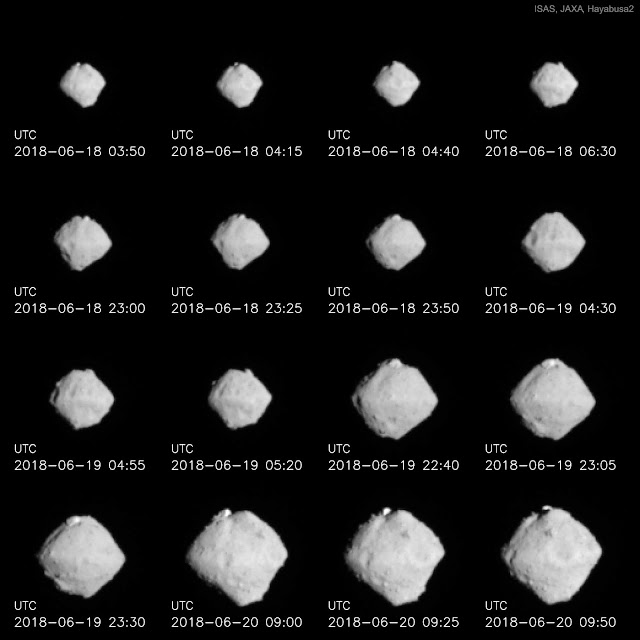JAXA - Hayabusa2 Mission patch.
June 27, 2018
The Hayabusa2 probe arrived Wednesday near its target asteroid to study the origin of life. Hayabusa2 has stabilized 20 kilometers from Ryugu, which is currently about 280 million kilometers from our planet.
Asteroid Ryugu seen from a distance of around 40km
The Japanese probe Hayabusa2 arrived Wednesday, after a journey of 3.2 billion kilometers, ready for its target asteroid where it must collect information on the birth of the solar system and the origin of life.
At 9:35 (00H35 GMT), after more than three years of travel, Hayabusa2 has stabilized 20 kilometers from Ryugu, which is currently about 280 million kilometers from our planet, announced the Japanese Space Agency (Jaxa).
Artist's view of Hayabusa2 arrival at Ryugu
The probe will now maintain this distance the time to fulfill its scientific purpose, the high point of which is throwing a projectile on Ryugu violently to cause a shock on the surface and collect the dust thus created.
The ultimate goal is to help enrich the knowledge of our space environment "to better understand the formation of the solar system and the emergence of life on Earth," says Jaxa.
2nd mission of this type for Japan
The first photos taken at 40 kilometers from Ryugu by Hayabusa2, launched at the end of 2014, excited the director of the mission: "the craters are visible, the rocks too, and the geographical structure seems to vary from one place to another", commented Yuichi Tsuda, on the website dedicated to this new space adventure.
Ryugu, which owes its name to a mythical castle of a Japanese folk tale, was originally presented as having a spherical shape, but it turns out to be different, close to the cube, he says.
This is the second mission of this type for Japan, the first having been an epic full of twists. "This time we want a mission less weighted with various problems," said the team.
Hayabusa2 images during Ryugu approach
As with the original Hayabusa mission (towards the asteroid Itokawa), the goal is to collect dust from the subsoil of this rocky celestial body that contains carbon and water, to try to understand what organic and aqueous matter were originally present in the solar system. The return to Earth is expected in 2020.
Hayabusa2 will also drop on Ryugu a robot called Minerva2 and an autonomous analyzer named Mascot, designed by the French National Center for Space Studies (Cnes) and its German counterpart DLR.
Mascot, whose lifespan is only a dozen hours, will use four instruments, including a spectral microscope developed by the French Institute of Space Astrophysics that will allow to know the mineralogical composition of the soil of the Earth. asteroid with the number 162173.
JAXA Press Release: http://global.jaxa.jp/press/2018/06/20180627_hayabusa2.html
More information: http://global.jaxa.jp/projects/sat/hayabusa2/
http://www.hayabusa2.jaxa.jp/topics/20180625je/index_e.html
Images, Text, Credits: JAXA/NXP/AFP/Orbiter.ch Aerospace/Roland Berga.
Best regards, Orbiter.ch




